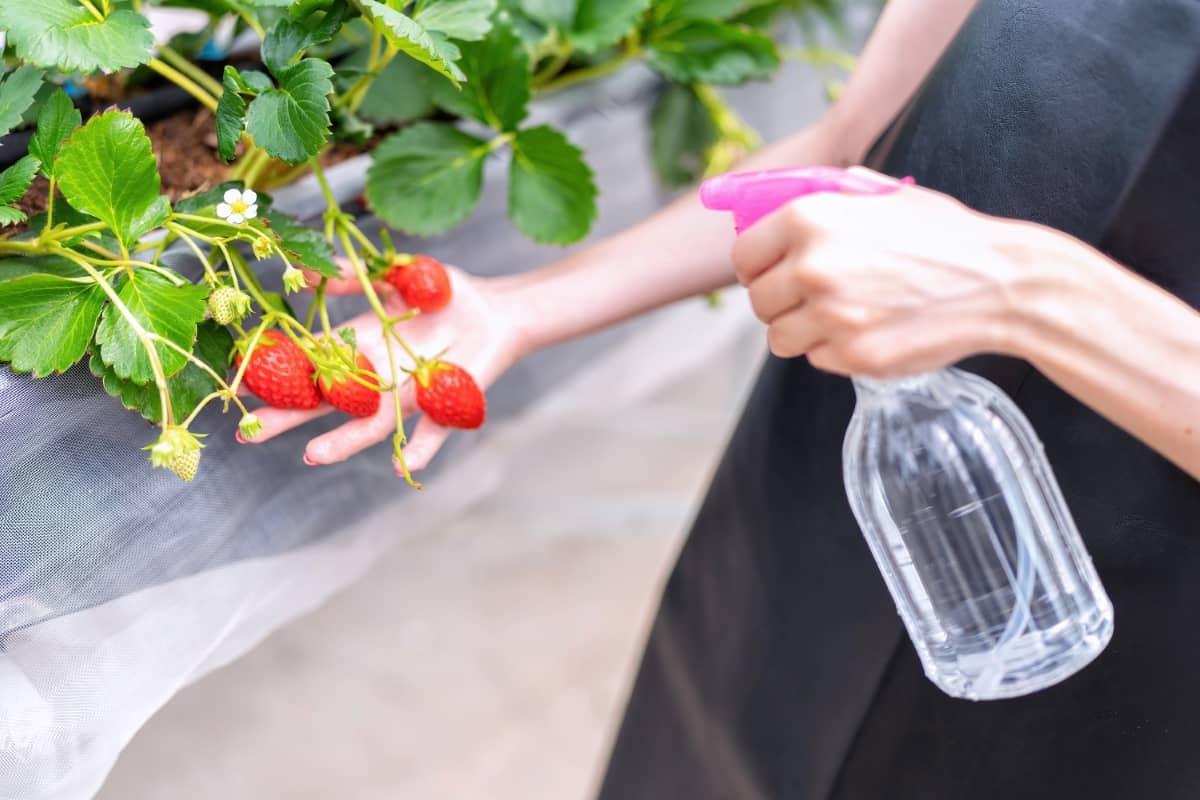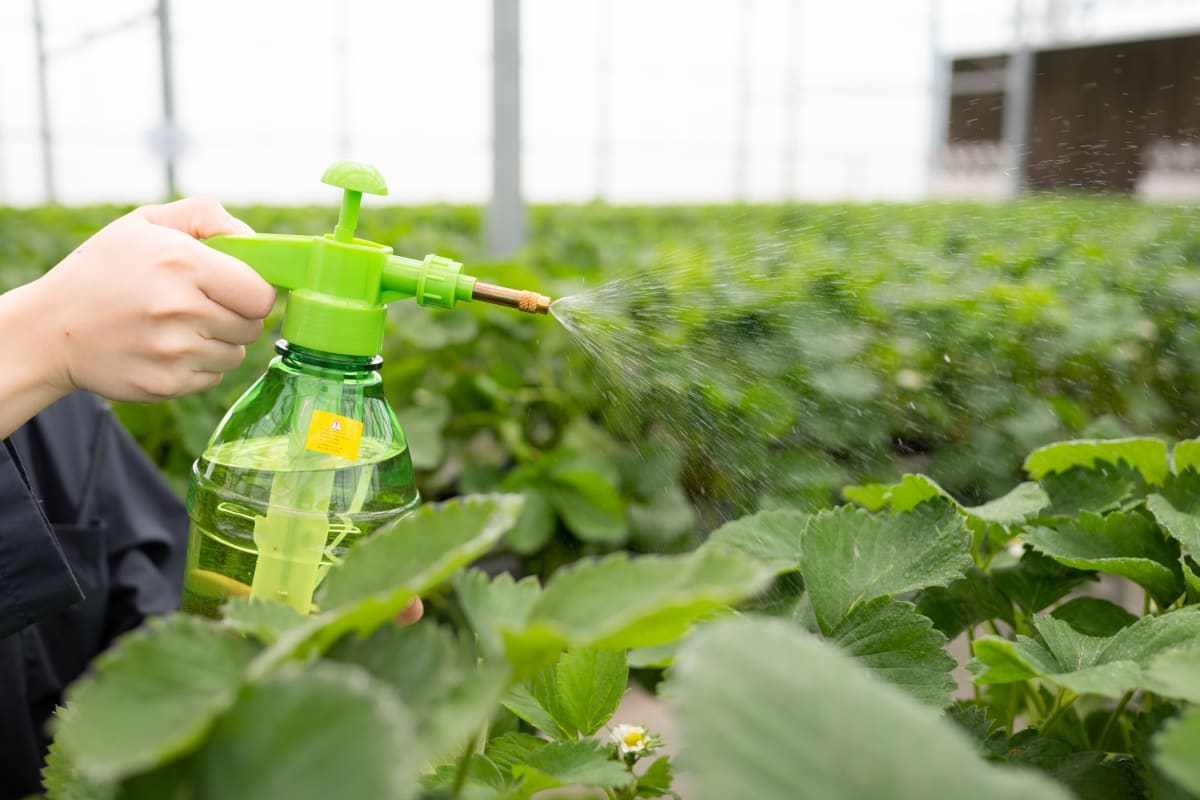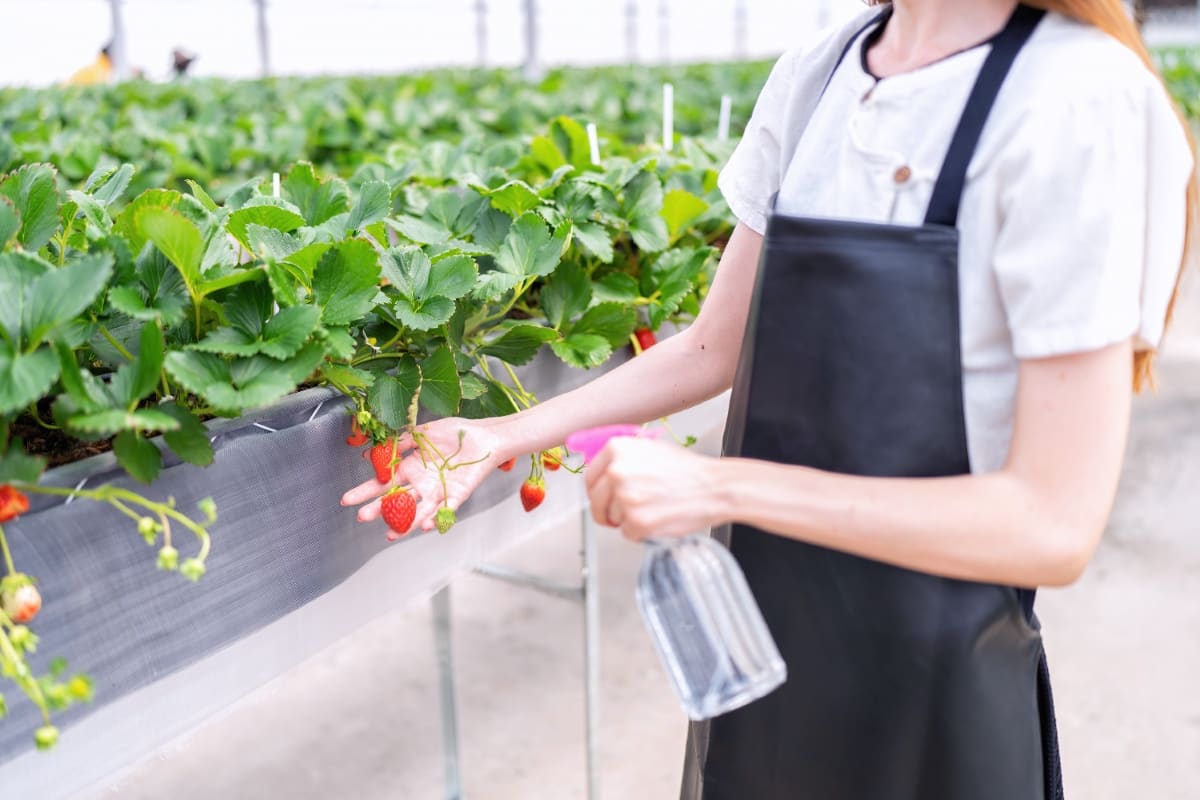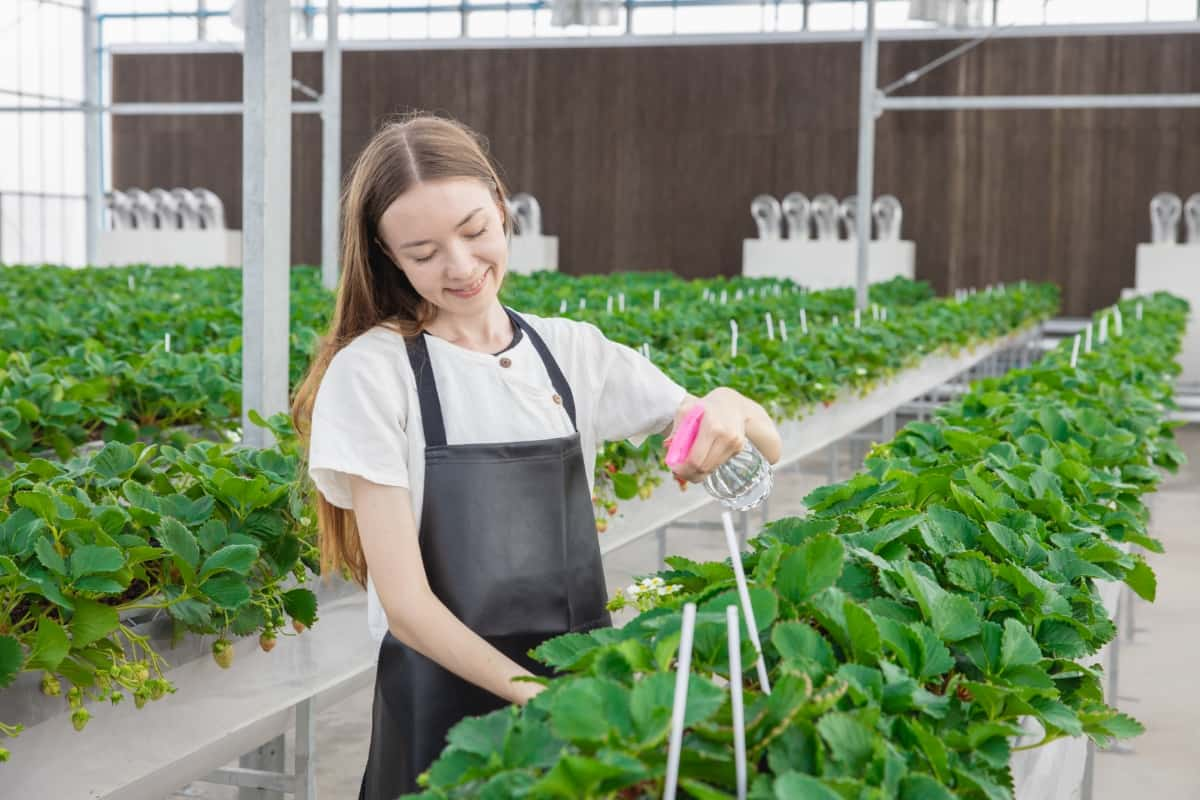Embracing homemade bug spray for strawberries is a cornerstone of organic strawberry plant protection, offering a sustainable solution to the age-old problem of garden pests. These eco-friendly strawberry bug deterrents, such as DIY natural pest control for strawberries, leverage the potency of ingredients like neem oil and soap solution to safeguard your plants without the harsh impact of chemical pesticides.

This approach ensures your strawberry beds’ health and supports eco-friendly garden maintenance and organic pest management strategies. Understanding common strawberry pests and the effectiveness of natural insecticides for strawberries is crucial for any gardener looking to implement safe pest control in strawberry gardens, thereby ensuring the thriving of beneficial insects for strawberry plants and the overall ecosystem of your garden.
Best Homemade Bug Spray for Strawberry Plants
Essential Ingredients
Neem Oil: Nature’s Insecticide
Neem oil spray for strawberry plants stands out as a powerful component in the arsenal of homemade pest control solutions. Its innate insect-repelling qualities render it a prime option for individuals in search of potent natural pesticides for strawberries. Neem oil disrupts pests’ life cycle, making it a cornerstone of DIY pest repellent for strawberries and a key player in organic pest management strategies.
Soap Solution: The Gentle Deterrent
A soap solution for garden pests offers a gentle yet effective means to free your strawberries from unwanted visitors. This non-toxic bug spray recipe creates an inhospitable environment for pests without harming the plants. It is an essential tool for anyone invested in sustainable garden pest solutions and safe pest control in strawberry gardens.
Preparation process
Recipe for Neem Oil Spray
To prepare neem oil spray for strawberry plants, mix a small amount of neem oil with water and a few drops of mild liquid soap to emulsify the oil, allowing for an even coating on your plants. This concoction serves as a potent eco-friendly strawberry bug deterrent, shielding against a broad spectrum of garden pests while ensuring the health and vitality of your strawberry plants.
How to Mix a Soap-Based Spray
Producing a soap-infused spray entails diluting a gentle liquid soap with water, yielding a solution suitable for direct application onto plants. This soap solution for garden pests breaks down the outer layer of soft-bodied insects, effectively deterring them from your strawberry beds while being gentle enough not to harm the plants.
Application Tips
Best Time to Apply Bug Spray
For maximum efficacy, the best time to apply bug spray is either early in the morning or late in the afternoon to avoid the hottest part of the day, which can cause stress to the plants. This timing ensures the spray has enough time to act on pests while minimizing potential harm to the strawberry plants and beneficial insects.
Frequency of Application
Regular application is key to preventing pest infestations in strawberry gardens. Depending on the pest pressure, applying your homemade bug spray every one to two weeks can help keep pests at bay and provide ongoing protection for your plants. You might need to apply more frequently for active infestations until the problem is under control.
Safety Measures
Protecting Beneficial Insects
When addressing pests, it’s essential to safeguard beneficial insects that support garden health. Applying sprays during periods when beneficial insects are less active, such as early morning or late evening, and focusing treatment solely on affected areas can mitigate harm to these important garden allies.
Ensuring Plant Health During Application
To safeguard your strawberries during application, it’s important to test the spray on a small area first and monitor for any adverse effects. Diluting the spray appropriately and avoiding application during extreme temperatures or direct sunlight can further ensure the well-being of your plants.
Enhancing Your Spray
Garlic and Onion: Adding Extra Repellent Properties
Incorporating garlic and onion into your bug spray can enhance its repellent properties, offering additional protection against pests. The strong scent of garlic and onion serves as a natural deterrent, making this addition a valuable component of DIY pest repellent for strawberries and a staple in organic pest management strategies.
Pepper Spray: The Spicy Barrier
Adding pepper to your bug spray introduces a spicy barrier that pests find unpalatable. This natural additive can deter many insects, providing your strawberry plants with an extra defense mechanism that complements the base effects of neem oil and soap solution sprays.
In case you missed it: 8 Common Problems with Garden-Grown Strawberries: How to Overcome Them

Troubleshooting Common Issues
Dealing with Resistant Pests
In cases where pests resist your homemade sprays, consider rotating between different spray formulations or increasing the concentration of active ingredients. However, always ensure that any adjustments remain safe for the plants and the environment.
Adjusting Concentrations
Some strawberry varieties may be more sensitive to spray ingredients. If you observe indications of stress or harm, decrease the spray concentration or rinse the plants with water post-application to minimize adverse effects, thus safeguarding the ongoing health and productivity of your strawberry garden.
Monitoring and Maintenance
Regular Checks for Early Detection
Regularly monitoring your strawberry plants is key to early detection of pest infestations. Catching problems early allows for timely intervention, increasing the effectiveness of your pest control efforts and minimizing potential damage to your plants.
Integrating Physical Barriers and Companion Planting
Beyond sprays, incorporating physical barriers like netting or row covers and practicing companion planting can enhance your garden’s defense against pests. These strategies provide additional layers of protection, contributing to a holistic approach to pest management in your strawberry beds.
Environmental Impact and Sustainability
Benefits of Eco-Friendly Pest Control
Adopting eco-friendly pest control methods, like homemade bug spray for strawberries and other DIY natural pest control strategies, significantly reduces the environmental impact typically associated with chemical pesticides. These organic strawberry plant protection methods ensure the safety of soil, water, and local wildlife, promoting biodiversity and supporting the ecosystem.
By choosing eco-friendly strawberry bug deterrents and sustainable garden pest solutions, gardeners contribute to a healthier planet, aligning their gardening practices with broader environmental conservation efforts.
Composting and Recycling Used Ingredients
Composting and recycling the used ingredients from natural pest control preparations further enhance the sustainability of gardening practices. Organic materials such as garlic and onion remnants from homemade sprays can be composted, returning valuable nutrients to the soil and reducing waste. This practice exemplifies sustainable garden maintenance and organic pest management strategies, closing the loop in garden ecosystems and contributing to a more sustainable environment.
In case you missed it: 9 Essential Steps to Grow Strawberries in Aquaponics: Explore from How to Plant to Harvest

Beyond Bug Sprays
Soil Health and Its Impact
Soil health plays a crucial role in pest management and the overall vitality of garden plants, including strawberries. Healthy soil fosters robust plant growth, making them less susceptible to pest infestations and diseases.
Integrating organic matter, maintaining proper soil pH, and ensuring adequate soil moisture and aeration are key aspects of soil management that can significantly reduce the reliance on pest control measures. This holistic approach to garden health, emphasizing the importance of a strong foundation in soil health, is essential for sustainable and effective pest management.
Attracting Natural Predators
Beyond using bug sprays, attracting natural predators to the garden is an effective and sustainable strategy for controlling pest populations. Practices such as planting native flowering plants, creating habitats for beneficial insects, and maintaining a garden environment that supports a diverse ecosystem can encourage the presence of natural predators.
Various predators such as ladybugs, lacewings, and birds play a crucial role in regulating pest populations, thereby minimizing the necessity for interventions and promoting a harmonious and healthy garden ecosystem. This approach complements homemade bug sprays, forming a comprehensive and environmentally friendly strategy for pest management in strawberry gardens.
In case you missed it: Strawberry Fertilizer Requirements and Recommendations: Management for Optimal Yield

Conclusion
Embracing homemade bug sprays and eco-friendly pest control methods offers a sustainable and effective approach to protecting strawberry plants from pests, enhancing garden health and environmental sustainability.
- Feed Your Flock for Less: Top 10 Tips to Save on Chicken Feed
- Ultimate Guide to Ossabaw Island Hog: Breeding, Raising, Diet, and Care
- Hatching Answers: The Top 10 Reasons Your Chickens Aren’t Laying Eggs
- Eggs and Economics: Breaking Down the Cost of Raising Backyard Chickens
- Defend Your Greens: Proven Methods to Keep Iguanas Out of Your Garden
- Ultimate Guide to Cinnamon Queen Chicken: A Comprehensive Guide for Beginners
- Ultimate Guide to California Tan Chicken: Breeding, Raising, Diet, Egg-Production and Care
- Ultimate Guide to Marsh Daisy Chicken: Breeding, Raising, Diet, and Care
- 10 Types of Chicken Farming Businesses You Can Start for Profits